There is a plethora of articles and information about which states are best for filling tags with big whitetail deer. You likely have heard that Wisconsin leads all states (by a large margin) when it comes to Boone and Crockett bucks this century, and you’ve probably also heard that Iowa, Kansas, and other Midwestern states are known for sizeable deer. But do you know which states have the highest success rates for hunters, or which states have the largest number of deer per square mile? Do you know which states have seasons that extend into February?
Taking a trophy deer is not the only way to have a successful hunt. Defining success on a hunt is a personal decision and while many factors are involved, often we find hunters define success as taking a large, mature buck.
Other times success is defined differently. Many people have different goals for different hunts throughout the season. Sometimes hunters know a specific big buck is in the area and the focus is on matching wits with him while letting smaller bucks walk and passing up chances to fill the freezer with a doe. Other times, however, you may be on a “meat hunt,” you may be looking to find new land to hunt, or you may be taking a youngster out with you and the goal is to see deer and/or get a shot at one, be it a doe or a buck.
This was the case with me in 2018 when I took my 13-year-old nephew hunting for several days, and then a few weeks later took my nine-year-old son out for a handful of sits in a stand. Both of them found it hard to sit still for the first few hours in the stand but after we saw some deer, they settled in and were able to be still and quiet in the stand for the next few days. They both ended up taking their first deer ever, and these are two of the most memorable hunts I have ever been on.
In this article, we will shine the light on some of the places you may want to eyeball when searching for places to hunt. These states aren’t always known for big bucks, but as a whitetail hunter, you should be aware of them for other reasons. No matter your goal, you can find a place (hopefully nearby) that fits your criteria for a hunting location using onX Hunt, the best app for deer hunting.
Best States Based on Hunter Success Rate
For this category, the approach is fairly simple: the number of deer harvested (from this National Deer Association (NDA) report, with estimates based on previous years where data was incomplete) compared to the number of hunting licenses sold. Not all of these hunters were hunting deer (for example, South Dakota has a lot of licenses sold to people who hunt pheasant), but data on estimates or totals for deer tags sold in many states was unavailable, so we factored in hunting licenses sold for this article.
Some people shoot more than one deer, so this doesn’t mean that a certain percentage of hunters were successful in shooting a deer. But it does give a good look into which states give you the best chance at putting meat in the freezer. South Carolina and Mississippi come in at .95, and Virginia and Delaware fall in right behind at .82 (meaning for every 100 hunters, 80 deer were harvested).
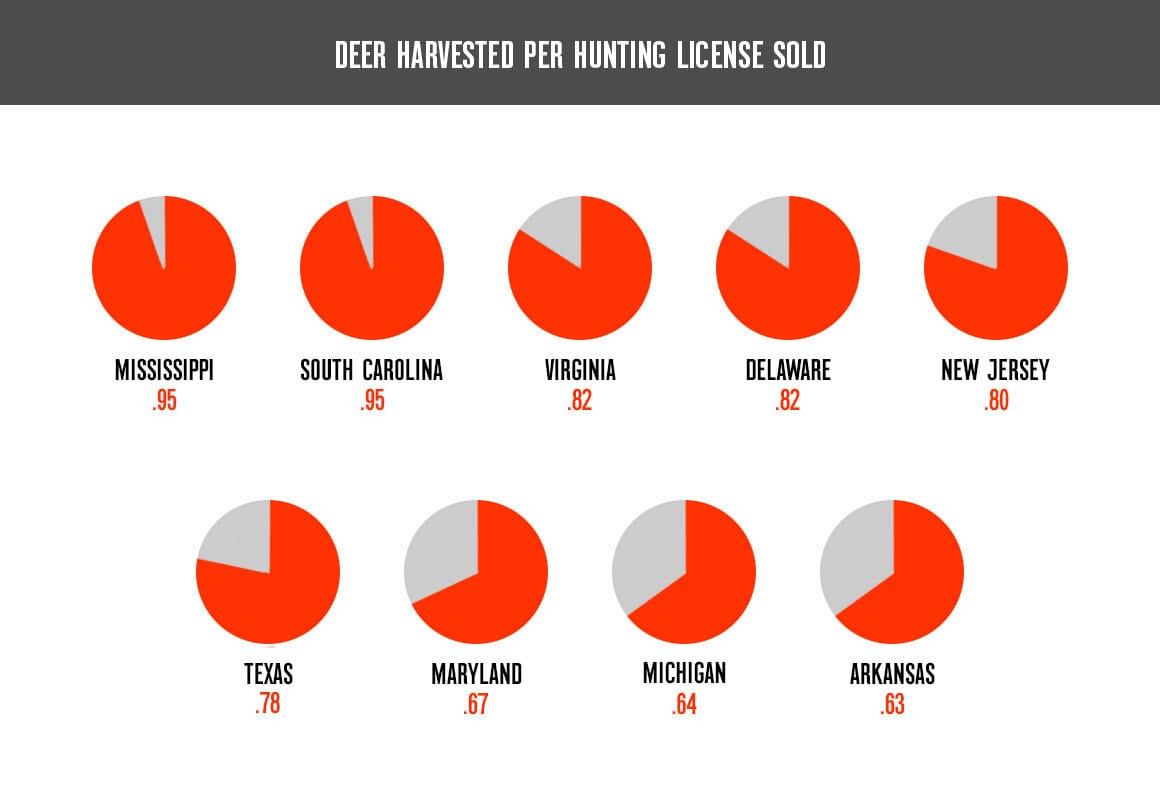
Best States Based on Bucks Harvested Per Square Mile
Here we are looking at the number of bucks harvested in relation to the size of the state. Different parts of the state will certainly have different deer population densities, so we suggest doing a bit of research on your own to further narrow your hunting location. However, on average these states lead the way when it comes to the number of bucks harvested in a season per square mile. Delaware, Michigan, and Pennsylvania tie for the most in the country with an average of 3.9 bucks harvested per square mile. South Carolina whitetail hunters average 3.2 bucks harvested per square mile, and Maryland is just behind at 3 bucks.
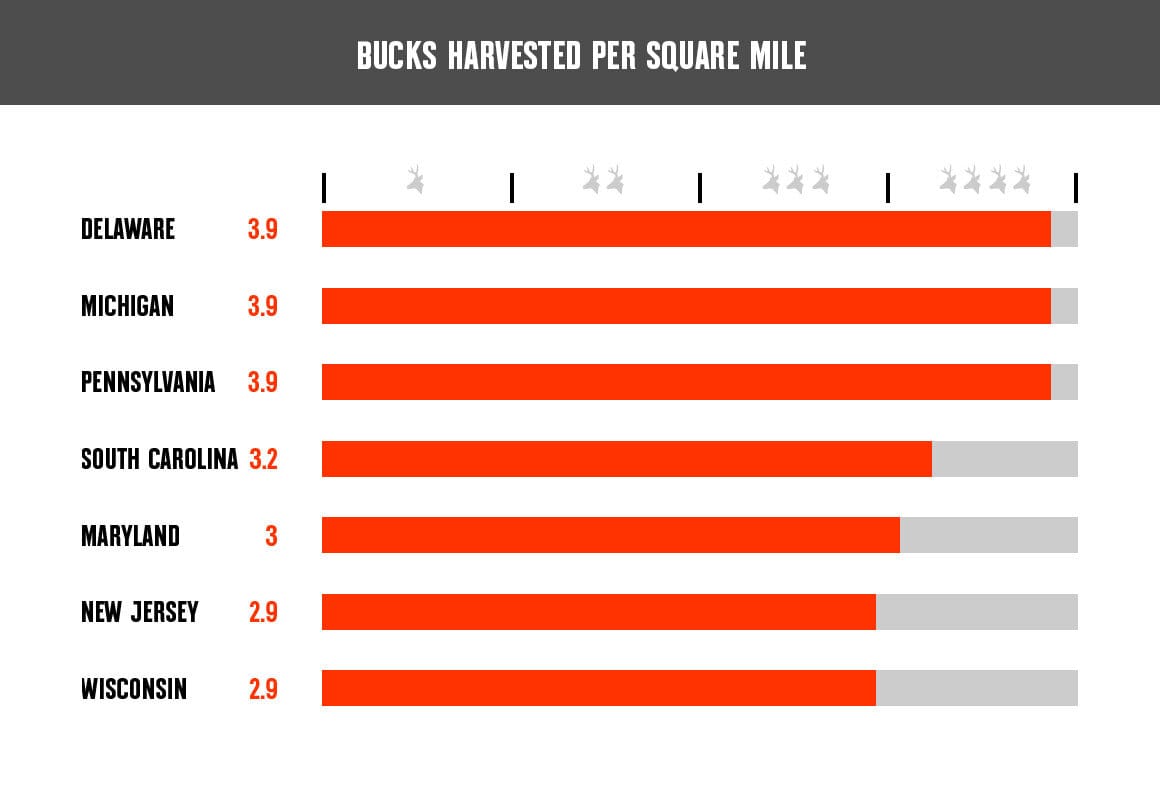
Best States Based on Public Land Availability
States in the West lead the country in the amount of public land available, with states including Wyoming, Utah, and Idaho making more than 50% of the state available to the public to hunt. Whitetail hunters should note that while there are whitetail deer in just about all of the Lower 48 and parts of Canada, for the purposes of this post we are focusing on states where whitetail are the primary big game species.
This data primarily comes from a report by Backcountry Chronicles and includes lands owned by the U.S. Forest Service, BLM, and the state (with sources and assumptions listed at the bottom of the report). Many states also have “walk-in” programs—essentially, private land made available to the public through some agreement between the landowner and the local or state government. These walk-in lands were included as well, although most programs list a rounded estimate of the land in their walk-in program, and the number of acres can change often or may be based off state data that may be a year or more old. Therefore, the walk-in program is a best estimate based on scouring individual state websites, but small differences don’t change the overall takeaways from this data.
Michigan is the only state offering more than 20% of its land to hunters (coming in at 20.3%), but New Hampshire, Minnesota, New Jersey, and Florida each make available more than 15% of the state to hunters, while Wisconsin, Pennsylvania, and New York are between 12% and 15%.
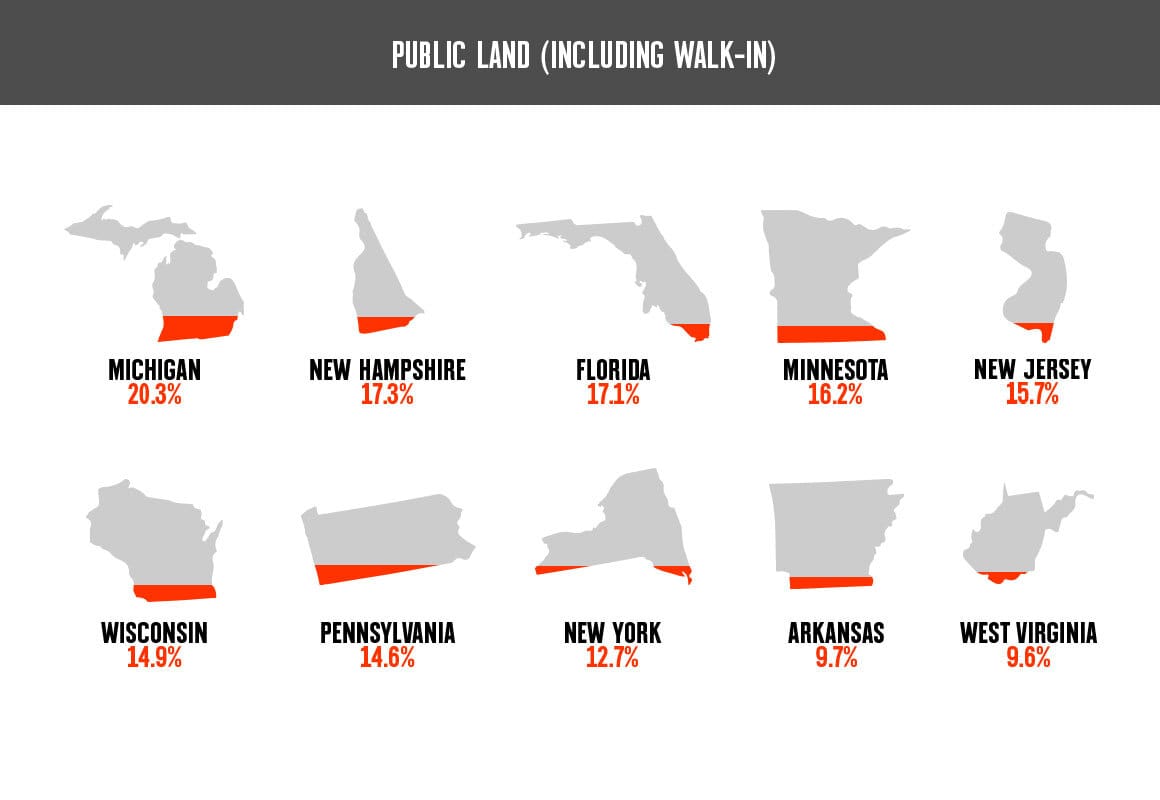
Best States Based on Number of Acres per Hunter
Some states have many hunters in the woods, while others offer relative solitude. The density of hunters often changes based on weapon; rifle season can be the most crowded time of year for most hunters. Some states, however, simply have fewer hunters in the woods than others. We compared the size of the state to the number of hunters. This formula gives the number of acres per hunter (the higher the number the less hunter-density), which is as low as 30 to 40 acres per hunter in some states (Pennsylvania and Tennessee). On the other end of the spectrum, four states have more than 200 acres for each hunter (North Dakota, Nebraska, South Dakota, and Florida), and 11 states offer more than 100 acres per hunter.
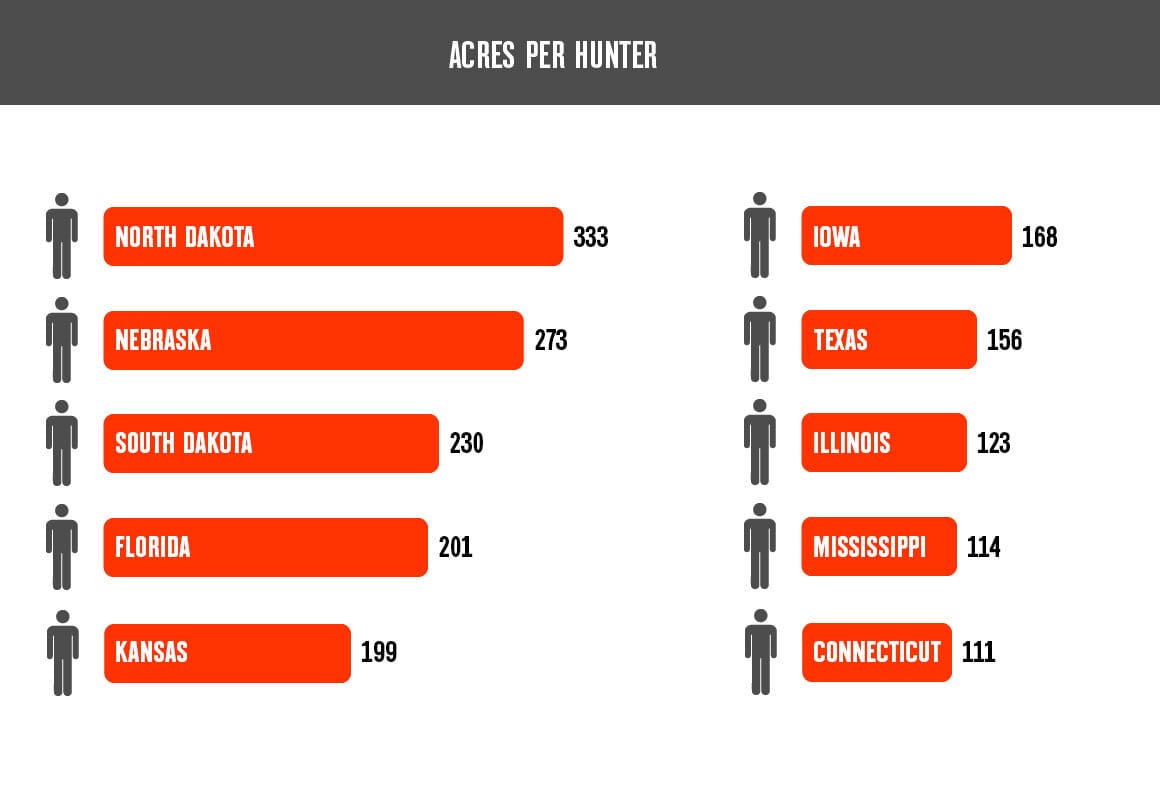
States Where You Can Hunt Into Late January or February
Seasons vary within many states based on unit or zone, and also on the type of weapon used, but these states each offer the hunter a chance at sitting in a stand well into the new year. Not only is the season longer, but the rut may be much later in these states as well, offering you a chance to hunt the rut in your home state and then hunt the rut again in another state. Seasons vary each year, so do additional research on any state you may hunt. If chasing whitetail in late January or February is what you’re after, explore these states.
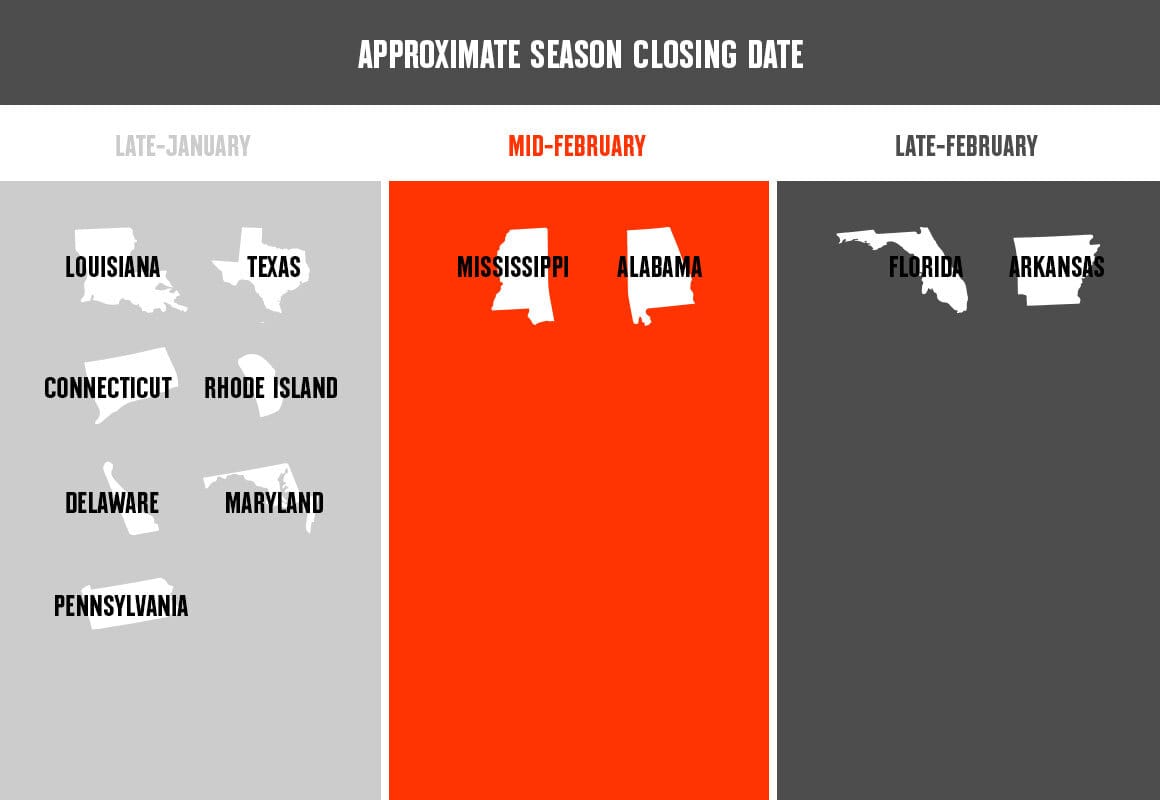
Best Whitetail Deer States Overall
So what states are best for whitetail deer hunting? The best states in which to hunt deer are going to be different for different people. The state that is best for you is the one that’s going to lead to the type of hunt you are looking for and also on how you define success for your hunt.
For further research check out Hunt Research Tools and the NDA 2022 Whitetail Report.
Click here to view the research behind this article on The Best Deer Hunting States conducted by onX’s own Tom Anderson and Todd Williams.